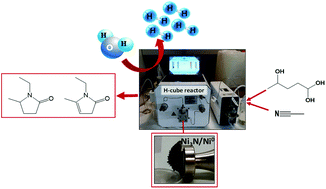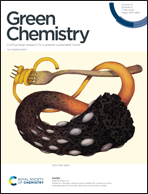Simplifying levulinic acid conversion towards a sustainable biomass valorisation†
Abstract
The demand for sustainable and robust catalysts for the valorisation of biomass is strictly related to the more and more pressing request to not only replace petroleum fuels with eco-friendly alternatives, but also to produce added value chemicals. In this context, the use of noble metals is not practically and economically sustainable and more abundant and stable alternatives are needed. In this contribution we have prepared and tested metal transition based catalysts (namely Ni3N and Ni nanoparticles) for the hydroconversion of levulinic acid (LA) as a model reaction. LA is useful also to produce valuable N-substituted pyrrolidones. Nanoparticles were prepared via a greener synthesis, using urea and metal salts, and have an average diameter of ∼30 nm (as ascertained by XRD and TEM studies). The main product of the levulinic acid hydroconversion was 1-ethyl-5-methylpyrrolidin-2-one. While this product was always the preferred one when Ni was used, Ni3N favoured the formation of the main product only in a shorter reaction time (below 1 h) with very high selectivity (up to 55% conversion), while a secondary product was formed in a longer time. The stability of the catalysts was also tested. To the best of our knowledge this is the first time that such a reaction is tested using transition metals and metal nitrides, with very promising results.



 Please wait while we load your content...
Please wait while we load your content...